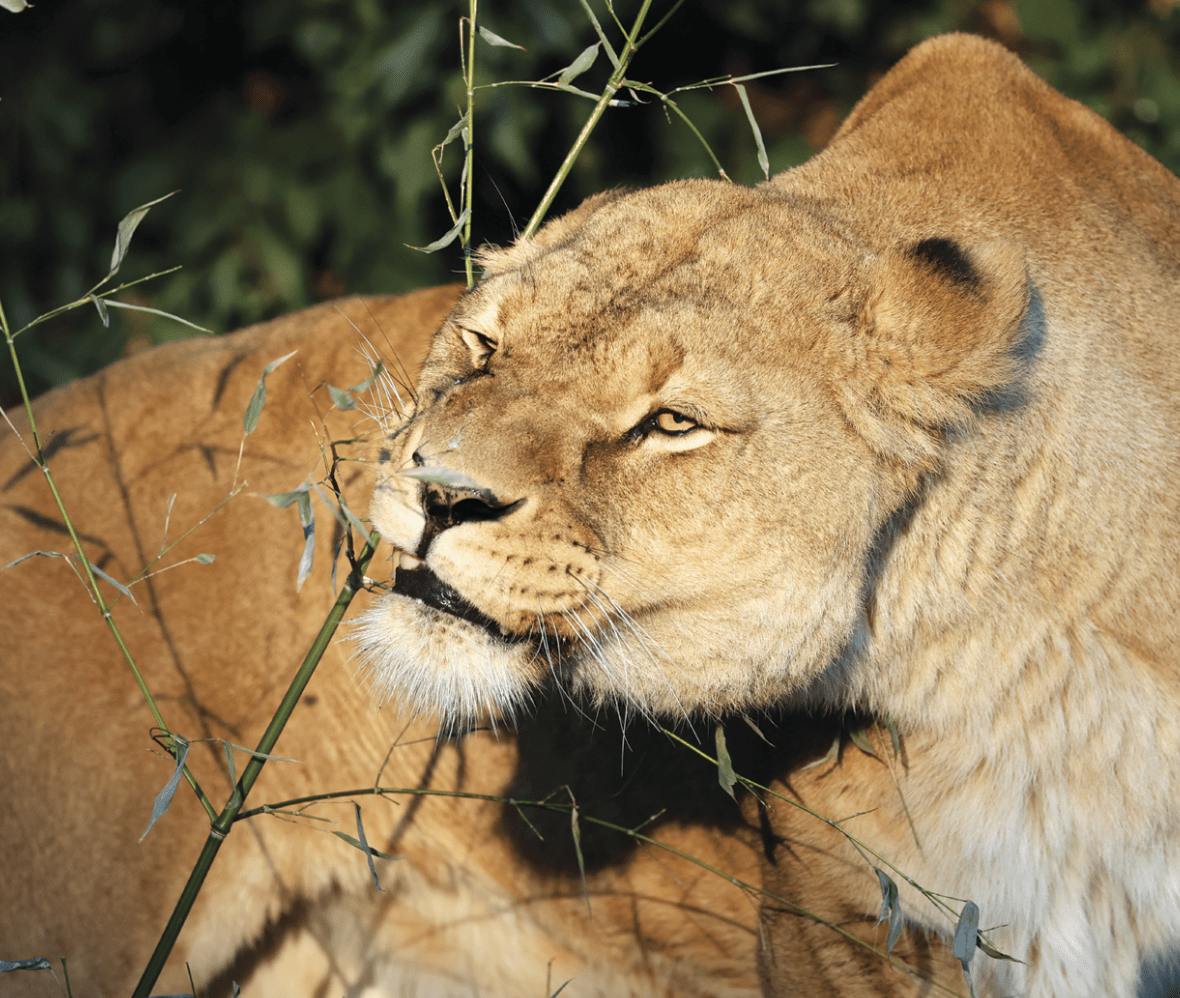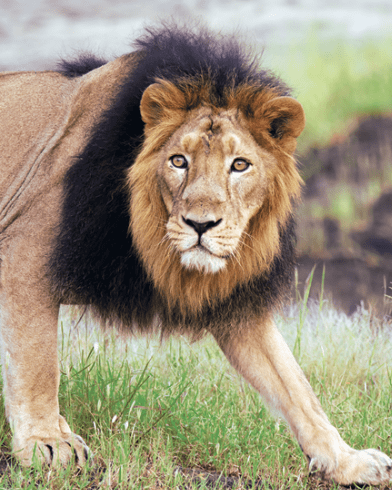
By Jim Knox
If you were to ask most kids and adults the difference between tigers and lions, they would invariably respond that tigers are orange with black stripes and lions are tan or golden brown in color. They would then inform you that tigers live in Asia and lions live in Africa. Aside from some anomalies in coat color, they would be correct. It is also true that all the world’s tigers live in Asia. Lions, however, might surprise you. Although most of the world’s lions live in the eastern and southern regions of Africa, these great cats are more widespread than you might suspect, and they hide their secrets well.
The Asiatic or Asian Lion (Panthera leo persica) is simultaneously a beast of legend and mystery. At a casual glance, this big cat is one and the same with its African cousins, yet a studious eye begins to tease out the subtle distinctions among these great cats. Unlike its better-known cousin, the Asian Lion typically sports a fine peppering of black or buff-gray spots in its coat. Aside from certain skull differences, males possess shorter, more sparse manes, rarely exceeding four inches in length, leaving their ears visible. All Asian Lions also possess a much larger tail tuft, a skin fold along their abdomen and typically attain smaller sizes than their African counterparts with males rarely exceeding 9.5 feet in length and 380 pounds in weight.
Inhabiting the fertile crescent and hunting the Tigris and Euphrates River Valleys for millennia, the Asian Lion has witnessed the birth of civilization, served as a competitor, lethal adversary, and timeless source of inspiration to humanity from our earliest days. Ranging into Europe from Albania and Greece eastward, their range wrapped around the entire Mediterranean basin. From present day Turkey, Palestine, Syria, and Egypt. To the east they ranged through present day Iran, Iraq, through the Caucuses and beyond to present day Pakistan and India.
With such an immense range encompassing the known civilized world for myriad cultures, the lion became synonymous with the sheer power, awe, and majesty of the wild world. This was the beast of the forests and limitless wilderness beyond the horizon—its untamed likeness adorning shields, coats of arms and royal crests. It was also the ultimate beast of dread—taking human and animal prey alike before 50,000 spectators at the Great Colosseum and hundreds of other lesser venues across the entirety of the Roman Empire.
Yet, fear of this lethal predator, economic losses from predation of domestic stock due to overhunting of the lion’s natural prey, and unsustainable capture of lions for the arena, led to inexorable population declines over the centuries. As early as 350 BC Aristotle referred to the lion of ancient Greece as, “A scarce animal not found in many places.” By the 10th century AD lions had disappeared from much of the Caucuses region. Predictably, their successive population extinctions cascaded; disappearing from Turkey by the 1870’s, Syria by 1895, and Iran by 1944. By the twentieth century, their range that had spanned across Europe and Asia had contracted to a tiny remnant area within India’s Gir Forest. Today, this protected population lives in the grasslands and deciduous forests of Gir National Park—once the royal hunting grounds of maharajas—and surrounding areas of the Indian State of Gujarat.
While this decline is not unexpected and parallels that of nearly all apex predators worldwide, there is reason for hope. From a perilously low population of as little as 10 animals, Asian lions have held on with an unmatched tenacity. Thanks to rigorous and pioneering protection efforts which include the relocation of human settlements and domestic stock and the protection of their hoofed prey species and forest habitat from fuel wood collection, the great cats have slowly increased their numbers over the last several decades to exceed the 500 individual mark. In recent years they have even extended their range beyond Gir National Park. The most recent survey in 2020 revealed lions had established six satellite populations in Gujarat and the population had reached a modern era high of 674 animals!
Buoyed by this success the Indian government has initiated bold lion reintroduction initiatives to Kuno and Barda Wildlife Sanctuaries, to safeguard against the risk of natural disasters such as forest fires or epidemics threatening these majestic cats.
Having lived alongside these great cats for thousands of years, what can we learn from them and how can we apply that knowledge to our own lives? In contrast to its perceived image, the Asian Lion is generally a retiring creature, with the ability to live alongside humans with rare exhibition of aggression. Capable of unmatched power, it engages when it must. Taking advantage of favorable conditions, these big cats expand their territories when opportunity presents itself. Social creatures, they access resources together and extend protection to the other members of their pride. Perhaps most significantly, when these cats get figuratively knocked down, they get back up. Clawing their way back from a worldwide population the size of a single pride, the Asian Lion is a true survivor. If we ever doubt our abilities, we only must look to these great cats to reaffirm that we are capable of roaring back from even the most daunting challenge.
Jim Knox serves as the Curator of Education for Connecticut’s Beardsley Zoo and as a Science Adviser for The Bruce Museum. His passions include studying our planet’s rarest creatures and sharing his work with others who love the natural world.


